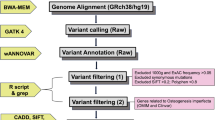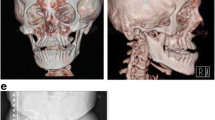Abstract
Osteogenesis imperfecta (OI) type I is usually caused by COL1A1 stop or frameshift mutations, leading to COL1A1 haploinsufficiency. Here we report on 12 individuals from 5 families who had OI type I due to an unusual cause—heterozygous deletions of the entire COL1A1 gene. The deletions were initially detected by semiconductor-based sequencing of genomic DNA and confirmed by quantitative PCR. Array comparative genomic hybridization in DNA of the index patient in each family showed that deletion size varied from 18.5 kb to 2.23 Mb between families, encompassing between 1 and 47 genes (COL1A1 included). The skeletal phenotype of the affected individuals was similar to that of patients with haploinsufficiency caused by COL1A1 stop or frameshift mutations. However, one individual with a deletion that included also DLX3 and DLX4 had tooth discoloration and bone fragility. Three individuals from 2 families had deletions that included also CACNA1G, and these individuals had learning disabilities. These features are not usually observed in COL1A1 haploinsufficiency, but are in accordance with previously described individuals in whom deletions included the same genes. In summary, we found deletions of COL1A1 in 5 out of 161 families (3 %) with OI type I that were evaluated. Deletions encompassing not only COL1A1 but also neighboring genes can lead to contiguous gene syndromes that may include dental involvement and learning disability.


Similar content being viewed by others
References
Marini JC, Blissett AR (2013) New genes in bone development: what’s new in osteogenesis imperfecta. J Clin Endocrinol Metab 98:3095–3103
Warman ML, Cormier-Daire V, Hall C, Krakow D, Lachman R, LeMerrer M, Mortier G, Mundlos S, Nishimura G, Rimoin DL, Robertson S, Savarirayan R, Sillence D, Spranger J, Unger S, Zabel B, Superti-Furga A (2011) Nosology and classification of genetic skeletal disorders: 2010 revision. Am J Med Genet A 155A:943–968
Ben Amor IM, Roughley P, Glorieux FH, Rauch F (2013) Skeletal clinical characteristics of osteogenesis imperfecta caused by haploinsufficiency mutations in COL1A1. J Bone Miner Res 28:2001–2007
van Dijk FS, Huizer M, Kariminejad A, Marcelis CL, Plomp AS, Terhal PA, Meijers-Heijboer H, Weiss MM, van Rijn RR, Cobben JM, Pals G (2010) Complete COL1A1 allele deletions in osteogenesis imperfecta. Genet Med 12:736–741
Harbuz R, Bilan F, Couet D, Charraud V, Kitzis A, Gilbert-Dussardier B (2013) Osteogenesis imperfecta, tricho-dento-osseous syndrome and intellectual disability: a familial case with 17q21.33-q22 (COL1A1 and DLX3) deletion and 7q32.3-q33 duplication resulting from a reciprocal interchromosomal insertion. Am J Med Genet A 161a:2504–2511
Mannstadt M, Lin AE, Le LP (2014) Case records of the Massachusetts General Hospital. Case 24-2014. A 27-year-old man with severe osteoporosis and multiple bone fractures. N Engl J Med 371:465–472
Dalgleish R (1998) The human collagen mutation database 1998. Nucleic Acids Res 26:253–255
Dalgleish R (1997) The human type I collagen mutation database. Nucleic Acids Res 25:181–187
Firth HV, Richards SM, Bevan AP, Clayton S, Corpas M, Rajan D, Van Vooren S, Moreau Y, Pettett RM, Carter NP (2009) DECIPHER: database of chromosomal imbalance and phenotype in humans using ensembl resources. Am J Hum Genet 84:524–533
Rauch F, Lalic L, Glorieux FH, Moffatt P, Roughley P (2014) Targeted sequencing of a pediatric metabolic bone gene panel using a desktop semiconductor next-generation sequencer. Calcif Tissue Int 95:323–331
Rothberg JM, Hinz W, Rearick TM, Schultz J, Mileski W, Davey M, Leamon JH, Johnson K, Milgrew MJ, Edwards M, Hoon J, Simons JF, Marran D, Myers JW, Davidson JF, Branting A, Nobile JR, Puc BP, Light D, Clark TA, Huber M, Branciforte JT, Stoner IB, Cawley SE, Lyons M, Fu Y, Homer N, Sedova M, Miao X, Reed B, Sabina J, Feierstein E, Schorn M, Alanjary M, Dimalanta E, Dressman D, Kasinskas R, Sokolsky T, Fidanza JA, Namsaraev E, McKernan KJ, Williams A, Roth GT, Bustillo J (2011) An integrated semiconductor device enabling non-optical genome sequencing. Nature 475:348–352
Merriman B, Rothberg JM (2012) Progress in ion torrent semiconductor chip based sequencing. Electrophoresis 33:3397–3417
Grasso C, Butler T, Rhodes K, Quist M, Neff TL, Moore S, Tomlins SA, Reinig E, Beadling C, Andersen M, Corless CL (2015) Assessing copy number alterations in targeted, amplicon-based next-generation sequencing data. J Mol Diagn 17:53–63
Kalkwarf HJ, Zemel BS, Yolton K, Heubi JE (2013) Bone mineral content and density of the lumbar spine of infants and toddlers: influence of age, sex, race, growth, and human milk feeding. J Bone Miner Res 28:206–212
Zemel BS, Kalkwarf HJ, Gilsanz V, Lappe JM, Oberfield S, Shepherd JA, Frederick MM, Huang X, Lu M, Mahboubi S, Hangartner T, Winer KK (2011) Revised reference curves for bone mineral content and areal bone mineral density according to age and sex for black and non-black children: results of the bone mineral density in childhood study. J Clin Endocrinol Metab 96:3160–3169
Rauch F, Schoenau E (2005) Peripheral quantitative computed tomography of the distal radius in young subjects—new reference data and interpretation of results. J Musculoskelet Neuronal Interact 5:119–126
Rauch F, Schoenau E (2008) Peripheral quantitative computed tomography of the proximal radius in young subjects—new reference data and interpretation of results. J Musculoskelet Neuronal Interact 8:217–226
Keynan O, Fisher CG, Vaccaro A, Fehlings MG, Oner FC, Dietz J, Kwon B, Rampersaud R, Bono C, France J, Dvorak M (2006) Radiographic measurement parameters in thoracolumbar fractures: a systematic review and consensus statement of the spine trauma study group. Spine 31:E156–165
Rauch F, Munns CF, Land C, Cheung M, Glorieux FH (2009) Risedronate in the treatment of mild pediatric osteogenesis imperfecta: a randomized placebo-controlled study. J Bone Miner Res 24:1282–1289
Takechi M, Adachi N, Hirai T, Kuratani S, Kuraku S (2013) The Dlx genes as clues to vertebrate genomics and craniofacial evolution. Semin Cell Dev Biol 24:110–118
Wu D, Mandal S, Choi A, Anderson A, Prochazkova M, Perry H, Gil-Da-Silva-Lopes VL, Lao R, Wan E, Tang PL, Kwok PY, Klein O, Zhuan B, Slavotinek AM (2015) DLX4 is associated with orofacial clefting and abnormal jaw development. Hum Mol Genet 24:4340–4352
Pollitt R, McMahon R, Nunn J, Bamford R, Afifi A, Bishop N, Dalton A (2006) Mutation analysis of COL1A1 and COL1A2 in patients diagnosed with osteogenesis imperfecta type I-IV. Hum Mutat 27:716
Price JA, Bowden DW, Wright JT, Pettenati MJ, Hart TC (1998) Identification of a mutation in DLX3 associated with tricho-dento-osseous (TDO) syndrome. Hum Mol Genet 7:563–569
Duverger O, Lee D, Hassan MQ, Chen SX, Jaisser F, Lian JB, Morasso MI (2008) Molecular consequences of a frameshifted DLX3 mutant leading to Tricho-Dento-Osseous syndrome. J Biol Chem 283:20198–20208
Najmabadi H, Hu H, Garshasbi M, Zemojtel T, Abedini SS, Chen W, Hosseini M, Behjati F, Haas S, Jamali P, Zecha A, Mohseni M, Puttmann L, Vahid LN, Jensen C, Moheb LA, Bienek M, Larti F, Mueller I, Weissmann R, Darvish H, Wrogemann K, Hadavi V, Lipkowitz B, Esmaeeli-Nieh S, Wieczorek D, Kariminejad R, Firouzabadi SG, Cohen M, Fattahi Z, Rost I, Mojahedi F, Hertzberg C, Dehghan A, Rajab A, Banavandi MJ, Hoffer J, Falah M, Musante L, Kalscheuer V, Ullmann R, Kuss AW, Tzschach A, Kahrizi K, Ropers HH (2011) Deep sequencing reveals 50 novel genes for recessive cognitive disorders. Nature 478:57–63
Barsh GS, Roush CL, Bonadio J, Byers PH, Gelinas RE (1985) Intron-mediated recombination may cause a deletion in an alpha 1 type I collagen chain in a lethal form of osteogenesis imperfecta. Proc Natl Acad Sci U S A 82:2870–2874
Bodian DL, Chan TF, Poon A, Schwarze U, Yang K, Byers PH, Kwok PY, Klein TE (2009) Mutation and polymorphism spectrum in osteogenesis imperfecta type II: implications for genotype-phenotype relationships. Hum Mol Genet 18:463–471
Acknowledgments
We thank Mark Lepik for preparation of the figures. FR received support from the Chercheur-Boursier Clinicien program of the Fonds de recherche du Québec—Santé. This study was supported by the Shriners of North America and the Fonds de recherche du Québec—Santé.
Author information
Authors and Affiliations
Corresponding author
Ethics declarations
Conflict of interests
Frank Rauch received support from the Chercheur-Boursier Clinicien program of the Fonds de Recherche du Québec—Santé and has received consultancy fees from Genzyme Inc and Alexion Inc. Francis H Glorieux has received consultancy fees from Novartis Inc, Amgen Inc, and Alexion Inc. Ghalib Bardai, Emmanuelle Lemyre, Pierre Moffatt, Telma Palomo, Joanna Tung, and Leanne Ward declare no conflict of interest.
Human and Animal Rights and Informed Consent
All procedures followed were in accordance with the ethical standards of the responsible committee on human experimentation (institutional and national) and with the Helsinki Declaration of 1975, as revised in 2000. Informed consent was obtained from study participants or the legal guardians.
Rights and permissions
About this article
Cite this article
Bardai, G., Lemyre, E., Moffatt, P. et al. Osteogenesis Imperfecta Type I Caused by COL1A1 Deletions. Calcif Tissue Int 98, 76–84 (2016). https://doi.org/10.1007/s00223-015-0066-6
Received:
Accepted:
Published:
Issue Date:
DOI: https://doi.org/10.1007/s00223-015-0066-6




